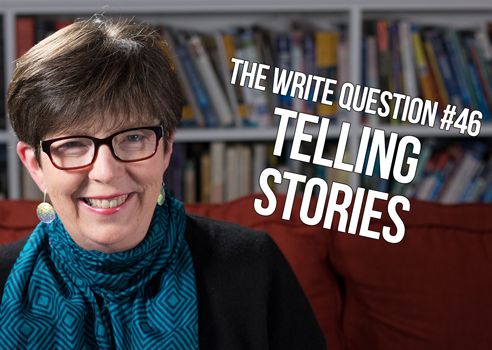Viewing time: 4 min. 42 sec.
The Write Question is a weekly video podcast about writing that I started in 2017 and that ran, more or less weekly, until April 2022. This is a republication of issue #46, about why you should start your stories in medias res. The post first ran on Feb. 16/18.
Transcript:
Welcome to The Write Question, I’m Daphne Gray-Grant. Today we’re talking about storytelling.
I’m answering a question from Susan Osborn in Lafayette, Colorado. Here’s what she asked.
[recording] “Thank you so much for a chance to get my question answered today. I have trouble when I’m looking at starting a chapter —when I go into a scene of a story deciding whether it’s going to start with dialogue, or describing the scene or some backstory. I feel like whichever one I start with takes me down a different path. I wonder if you have any advice for what to consider when you’re working on introducing a scene and concept. Thank you!”
Thanks for the question, Susan. I’m so glad you asked me about storytelling because not nearly enough non-fiction writers use it as a core part of their process.
Stories make writing memorable. Learning how to tell a story well is an important skill for everyone, but especially for writers. Part of what makes someone good at it is they have an excellent sense of pacing. This involves not just how quickly they tell the story and how much detail they include, but where they begin.
I see many newbie writers who feel a great urge to set everything up before they tell the story. They want to introduce every character, go into every one of their backgrounds, and present a summary of what’s going to happen. But this information isn’t always necessary. There is a real danger of spoiling the impact of a story if you do this.
Almost always, the best place to begin a story is in medias res, “into the middle things.” The term was coined from Homer’s epic poems, The Iliad, The Trojan Cycle, and The Odyssey. All three of the stories start in the middle of the action and then jump back to the beginning. Another example is novel To Kill a Mockingbird. The book opens with Scout and her brother discussing how far back you’d have to go to explain how he’d broken his arm. The novel then goes back to cover the events that led up to his broken arm.
When you begin in the middle of the action you’re able to grab the audiences’ attention almost immediately.
It’s easy to start a story at an exciting point when it’s all fictitious. But, non-fiction writers can use the same strategy too. Let me read to you from the beginning of the book The Power of Habit, by Charles Duhigg.
“In the fall of 1993, a man who would up end much of what we know about habits walked into a laboratory in San Diego for a scheduled appointment. He was elderly, a shade over six feet tall, and neatly dressed in a blue button-down shirt. His thick white hair would have inspired envy at any fiftieth high school reunion. Arthritis caused him to limp slightly as he paced the laboratory’s hallways, and he held his wife’s hand walking slowly as if unsure about what each new step would bring.
About a year earlier, Eugene Pauly, or “E.P.” as he would come to be known in medical literature, had been home in Playa del Rey, preparing for dinner, when his wife mentioned that their son, Michael, was coming over.
“Who’s Michael?” Eugene asked.
“Your child,” said his wife, Beverly. “You know, the one we raised?
Eugene looked at her blankly. “Who is that?” he asked.
I’m not going to tell how this story ends. You should read the book; it’s a good one. But I want you to notice how Duhigg just dove right into the story of a single individual who was having some sort of health problem. We don’t know what it is, or how this story relates to habits.
But, we all want to know what’s going to happen next. It’s almost like a thread that can pull us through the chapter. It represents the power of story and the particular power of telling it in medias res.
Finally, while we’re on the subject of storytelling, let me wrap up with a quote from novelist Graeme Green: “A story has no beginning or end: arbitrarily one chooses that moment of experience from which to look back or from which to look ahead.”
Thanks for your question, Susan. I hope you are able to look backwards, forwards and sideways as you tell your story.
Links
The Power of Habit by Charles Duhigg.


